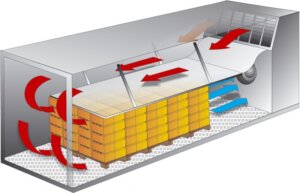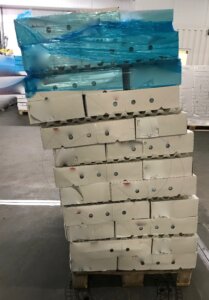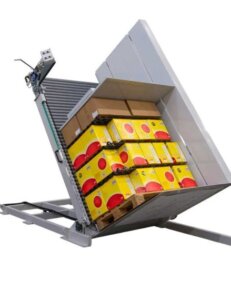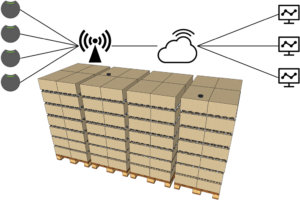Home Freezing strategies When blast freezing foodstuff there are basically...
Read MoreBlast Freezing Q&A
Published as “Blast Freezing Tips” in the December 2012 issue of Pacific Fisheries Bering Sea and Distant Water Fleets Review.
By Rick Greenquist, Highland Refrigeration
Blast freezing is the workhorse method of freezing seafood products in the fishing industry, simply because it is the most versatile. Second behind blast freezing is plate freezing, which is the king of block frozen products. In third place is brine freezing, which is specific to products that either tolerate salt uptake, like tuna, or are enhanced by salt uptake, like crab. But for the vast majority of seafood products that rely on both taste, texture, and a visual presentation, blast freezing is the most productive and versatile investment to a frozen seafood production plant.
Blast freezing is the process of pushing cold air at high velocity across a food product in order to freeze the product as quickly as possible. Blast freezers come in a variety of configurations, from single-load freezers that freeze batches of products, to “continuous” freezers such as tunnel freezers that continuously freeze product as it moves through the freezer on a conveyer belt.
The primary goal in blast freezing is fast freeze times. Fast freeze times are important for a number of reasons – the most obvious being production efficiency – getting the most production out of the least amount of production space is important in every industry. However, the most compelling motivation is the economics of quality. High quality food products can be pushed into high price markets, but low quality products are left to the low price markets – plain and simple. Blast freezing is an effort on the part of frozen food producers to preserve as much of the quality as was present in the raw product as possible in order to position their products before the type of customers that are willing to pay the most for the very best quality
But what do freeze times have to do with preserving quality? What are the elements that make for great blast freezing equipment? Are there ways of improving the freezing effectiveness of existing equipment? These are fundamental issues important to every frozen food producer.
Here are some frequently asked questions that will give you a measure of good sense in gaining the highest quality and productivity from your blast freezing operation.
Welcome to our Blast freezing Q&A – click any and all questions that might interest you
- Why is freezing speed so important to quality?
- Is there a balance point between air velocity and temperature?
- “Low temperature vs. Big fan”
- You cannot keep increasing the fan horsepower to improve your freezing times can you?
- How do i know when to consider the freeze finished?
- How do I know how to make some kind of basic assessment?
- The “evaporator” – what is it, what does it do?
- What do you mean by “air flow design”?
- “Enclosure integrity” – this refers to the blast freezer room?
- But at what point should an owner consider a more premium operation?
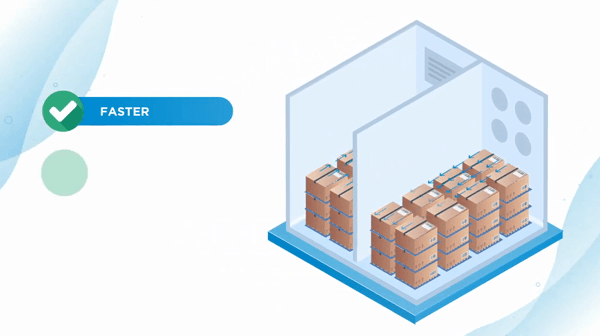
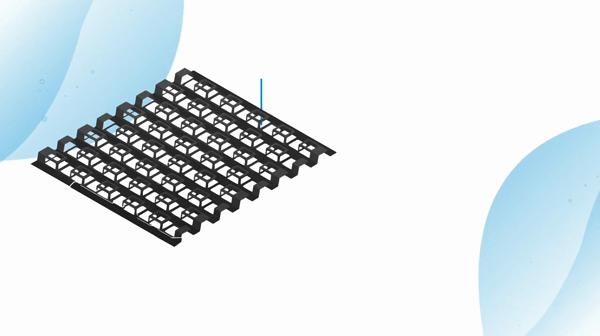
Q - My first question is why is freezing speed so important to quality? Whether fast frozen or slow frozen, it seems to me that a frozen fish is a frozen fish!
A – Good question! How quality is preserved during the freeze cycle is related to the way water within the product cells freezes – at the molecular level. As the cellular contents loose energy, the water molecules start to bond with each other to form solid ice. However, these water molecules do not just bond with each other in random patterns, they bond in orderly “lattice work” patterns that eventually form pure ice crystals within the cells. The formation of pure ice crystals excludes the other dissolved constituents of the cell interior, so that the concentration of the excluded non-water substances such as various enzymes and electrolytes increases, and through a variety of mechanisms, damage the cell walls. The slower the freeze, the more time each water molecule has to migrate into the most favorable position, hence the formation of large crystals of pure ice and heavy concentrations of cell damaging enzymes and electrolytes. In a fast freeze where molecules have less time to find the most favorable position, a less orderly pattern takes place with much smaller crystals forming. The result is that the enzymes and electrolytes become isolated in smaller pockets within the disorderly array of small ice crystals. With less of the enzymes and electrolytes in contact with the cell membrane, less damage occurs, so that when the product is thawed, there are fewer damaged cells, and thus firmer flesh, with a closer resemblance to the fresh state of the product. When the slow frozen product is thawed, the damaged cells spill their contents into the surrounding flesh and drain away. The cellular structure loses its integrity and firmness. It becomes soft, mushy, and wilted – and less desirable to the consumer.
Q - That is fascinating! Now in your initial statement, you describe blast freezing as a “cold air at a high velocity”. Is there a balance point between air velocity and temperature? For example, can I set up some fans in a part of my cold storage to make a blast freezer?
Q - Ok, but I am still interested in the “low temperature vs. Big fan” issue. I keep thinking about my chest freezer at home. We put stuff in it to freeze and it seems to do just fine, without any fans. I understand the need to freeze quickly, but how about a room with – say -30f and no fans. You could save energy that way. Wouldn’t that work?
Q – wow! Now I understand why fans are so important. But isn’t there an optimal air speed? You cannot keep increasing the fan horsepower to improve your freezing times can you?
Q – So let’s say I have progressed well into the freeze cycle. How do I know when to consider the freeze finished?
A – Excellent question! However, the answer is not so simple. The best way to determine the end of the freeze cycle is by experimenting with that type and size of product to determine at what core temperature you need to pull the product so that after a one-hour period in the cold storage, the product temperature will have equilibrated to the surrounding cold storage temperature. For example, let us say that your customer requires a 10F temperature for product core, cold storage and shipping. Your blast freezer air temperature at the end of the freeze is -35F. Do you pull the product at a core temperature of -10F? No! At that core temperature, the product surface temperature is probably around -30F, and after 1 hour in the cold storage, the temperature will probably equilibrate to around -20F. That is colder than the cold storage! My point is that if the equilibrated temperature is lower than the cold storage temperature, then you have overcooled the product. The product will warm up to temp in the cold storage. You wasted energy, product hydration, and valuable production time by extending the freeze time beyond what was needed.
What if, by experimentation, you found that pulling the product at 0F core temperature, glazing, casing, and transporting to the cold storage, the product temperature equilibrated to 10F after 1 hour? At that point, you have fulfilled your customer’s requirement in a very practical way, saved energy, and put your blast freezer back to work on the next freeze.
So how do you take the core temperature? You select random samples from various locations in the freezer; drill a hole the size of the temperature probe you will be using so that you can take the temperature in the middle of the product mass. Treat the samples in the same way as the rest of the product – that is glaze, case, palletize and move to cold storage in the same manner as all other product. After one hour, take another round of core temperatures. Repeat the process until you have determined with repeating results, the best core temperature at which to pull the product, and the associated freeze time. Repeat the process from time to time to verify your optimal pull time with repeating results.
The product samples that you drill should be considered sacrificial since you will probably not be using sterilized instruments. You must make sure that you use the same temperature-measuring instrument that has been properly calibrated. Leave the work of measuring core temperatures, and determining pull times to a quality assurance team that can take a deliberate and precise approach. If you are very thoughtful and accurate with your core temp studies, you will very quickly develop good sense on blast freezer pull times in your particular operation.
Q – I think I have a handle on the basics now. But how do i translate this into some basic understanding of the equipment, so that when I look at a blast freezer, I’ll know how to make some kind of basic assessment?
A – Good question! Let us go through some basic elements of a blast freezer. I will list them off and we will deal with each issue one at a time. We will start with the air handling unit – or what we refer to in the refrigeration industry as the “evaporator”; we will progress through the airflow design; and then enclosure integrity.
Are we ready?
Q – Absolutely! Where do we start again? The “evaporator” – what is it, what does it do, and how do i know whether it will be effective in blast freezing duty?
A – The evaporator consists of an arrangement of tubes into a “coil” through which the refrigerant passes. There is a meshwork of thin metal fins that act to extend the refrigerating surface of the coil of tubes. The amount of refrigerating surface in the coil determines the refrigeration capacity (and purchase cost) of the coil. The larger the surface, the less temperature difference between the refrigerant and the air will be required to do the work of refrigeration. Why is this important? To achieve a -30F air temperature, you want to have a -40F refrigerant temperature; hence, a 10F TD (temperature difference). A cheap blast freezer evaporator that has only half of the refrigeration surface, will require -50F refrigeration temperature in order to achieve a 30F air temperature – thus a 20F TD. This makes the refrigeration equipment (the compressor) work much harder. Furthermore, a very high temperature difference increases product dehydration. So the rule of thumb: the larger the evaporator, the better! Look for an evaporator that has a face area very close to the cross sectional area in which the product is arranged.
Another very important feature of a blast freezer evaporator is the spacing of the fins through which the refrigerant coils pass. As I mentioned earlier, the purpose of these “fins” is to extend the surface area of the coil. Fin spacing in an evaporator coil is extremely important due to frost formation. Blast freezing will pick up a fair amount of moisture from the surface of the fish, as we discussed earlier. If the fin spacing is too narrow, the evaporator will very quickly become plugged with frost, blocking airflow, stopping the blast freezing process. Look for fin spacing that gives no more than three fins per inch. If you want to view a good comparison, look at the fin spacing in a cold storage evaporator – it will be much denser – up to seven fins per inch. When you are looking at fin spacing, make sure to compare both sides of the coil! Often blast freezer evaporator manufactures will provide wide fin spacing at the air inlet of the evaporator to catch moisture, and narrow fin spacing at the outlet of the freezer to give better evaporator performance.
The fans are as critical to the operation of the blast freezer as refrigerant coil surface. The greater the volume of air passing through the coil and the product, the faster the freeze time will be. Look for fans that fill the face area as much as possible. If you are purchasing new evaporators, ask what the fan static pressure beyond the evaporator will be – well sized fans should be able to develop 1/2″ to 1″ water column pressure (a way of measuring fan static pressure) external to the unit discharge in order to do the job of blast freezing. In most cases, high-powered fans will require heavy-duty fan assemblies of cast aluminum, whereas cold storage duty fans are quite often constructed of stamped sheet metal.
Finally, the blast freezer evaporator must have a means of defrosting, either electric or “hot gas”. Electric defrost depends on electric elements that pass through the coil, supply heat during the defrost cycle to melt the frost. Hot gas defrosted coils, during the defrost cycle, use compressor discharge gas to pass through the same tubes that liquid refrigerant passes during the freezing cycle. During the defrost cycle, the compressor discharge gas will condense into liquid refrigerant, and thereby give up its heat in order to melt frost (the reverse of refrigeration!). Not all coils defrost well, so it is very important to keep an eye on the success of the defrost – to make sure that the coil is completely clear of frost. If not, then the subsequent freeze cycle will be impeded by blocked airflow. Repeated freeze cycles after incomplete defrost cycles can eventually ruin the coil due to ice damage.
Q – Airflow design – that doesn’t sound like a piece of equipment, what do you mean by “airflow design”?
A – Air flow design has to do with the whole interior of the blast freezer that directs the air through the product at a design velocity, and returns the air to the evaporator for re-cooling. Here is a list of points that should give you some common sense on what makes for a good airflow design:
Evaporators that fill the entire cross sectional area of the compartment where the product is located are better at producing uniformity in temperature and freeze times, than smaller evaporators.
Blast freezers with a “once through” air flow design with a return air plenum are better at producing uniformity in temperature and freeze times than blast freezers that blow air through the top of the product racks, let the air turn around at the front of the box, and return air through the bottom of the same racks.
A good airflow design includes “turning vanes” or sheet metal structures that provide a turning radius for the air to follow, instead of sharp corners – when it becomes necessary to make the air change direction. For example, in a square box, it is necessary to make the air change directions for a total of 360 degrees; each of the turns occurs in the corners of the blast freezer. Turning vanes in these areas helps reduce the pressure drop by reducing turbulence friction.
Good airflow design matches the freezing compartment with the size of the product racks so that there is very little space for the air to bypass around the product. Air will always follow the paths of least resistance, which means that every opportunity for the air to bypass the product, it will. When air is bypassing product, the result is lower airflow through the product racks, and therefore higher temperatures next to the product.
Q – “Enclosure integrity” – I take it that this refers to the blast freezer room?
A – Correct – the whole space that involves the evaporator, product freezing area, return air (or supply air) plenum, doors, and even the piping that carries the defrost water away are all part of the enclosure. Enclosure integrity has to do with heat and moisture infiltration. Here is a list of points associated with enclosure integrity:
A poorly insulated box will conduct heat from the outside of the box to the interior, therefore defeating a percentage of the refrigeration capacity of the machinery.
A box with deteriorated insulation – such as waterlogged insulation is often a worse insulator than no insulation at all!
Best insulators are urethane or polyurethane panels with sheet metal skins that are foamed in place at the factory, as opposed to laminated sections of foam between the sheet metal skins.
Glass wool is not acceptable at refrigeration temperatures since it provides no barrier to moisture migration, Glass wool eventually becomes logged with ice.
Doors that will not seal properly are the single most common cause for excessive freeze times than anything else. The cause is usually worn or missing door gaskets, warped doors, damaged doors, or improperly adjusted door hardware such as hinges or latches. Go inside the box and have an associate on the outside close the doors in the same manner as when the box is in production, keep the interior light off, and look for light around the doors. Any gap, no matter how small, will allow air and the moisture that air carries into the blast freezer. Yes, the warm outside air will rob the refrigeration equipment of capacity, but more than that, the air that infiltrates the box during the freeze will drop off its moisture in the evaporator coil, and quickly plug the coil with frost! The single most important way to improve freeze times is to fix the door leaks!
Defrost water piping that carries the defrost water to the outside of the box is a very common source of moisture infiltration if the outlet of the pipe is not trapped. If no “P-trap” is installed at the end of the defrost water pipe, air will get pulled through the pipe when the fans are running, and all of the moisture that comes with the air will condense, freeze, and plug the evaporator coil with frost in very short order.
Also, look at electrical conduit penetrations to the evaporator. Your electrical installer should have sealed the interior of the conduit where it penetrates the box with either foam, putty, or caulk that has been approved for electrical conduit use. If not, the conduit will allow the infiltration of moist air into the box. In fact, over time it will completely fill the conduit, and freeze-damage some spots!
Q – fabulous! This has been quite an interesting journey! You have laid out a case for what seems like huge evaporators, high-powered compressors, very low temperatures, doors that seal tight, and a box interior that is perfectly matched to the way the product is staged. I’ve seen that kind of equipment in the best production plants and processing vessels, but i see plenty of producers with equipment that is less than perfect; and they seem to keep chugging along forever. I can see a new operator getting started under these conditions, but what at what point should an owner consider a more premium operation?
A – That is a very good question. Yes, we have a very diverse industry of producers and buyers that will fill every niche in the frozen seafood marketplace; and every producer can decide in what market he or she wishes to do business. This is all good business activity, but there is no need to make any kind of case for the type of equipment that does well at the bottom of the quality market since there is no forward momentum there. Why not look at the top quality producers, both large and small, and how they engage with the marketplace? They are the ones driving the standards, and they will ultimately draw the market in their direction. To make a simple analogy: the quality expectation in the Frozen Fish Sticks market will ultimately be driven by the expectations in the premium quality seafood market, not the other way around; so let us fix our eyes on premium quality, and engage with the market from that perspective. Therefore, in conclusion, in order to produce top quality frozen seafood, you must focus on fast pull down times and very short freeze times; and there is a level of mechanical technology and innovation that will be required to get to that point.
I hope that this very brief question and answer session has opened up some possibilities for you! When I look back across the last three decades in the seafood industry, I see quite clearly that the best quality seafood products that have ever been produced are being produced right now; and I hope that this article has made some small contribution to continuing an upward progression in the quality of what we are putting on the table across the globe.
Reduce your energy consumption by up to 50%
Is your current blast freezing setup creating the optimal energy cost reduction? Read about the benefits of our spacer models.

Cost-effective
Due to the robust structure of High-Density Polyethylene, our freezer spacer withstands temperatures between -50°C and +90°C and is resistant to acids and chemicals, ensuring a long lifespan, even in the toughest working environments.

Practical
The low weight and open design make it easy to handle and to clean the freezer spacer. The spacers nest easily into each other when not used, thereby taking up a minimum amount of space.

Efficient
The open profiles result in maximum air contact with the stacked layers of products, ensuring faster and more efficient freezing of the whole pallet load.

Environmental
The spacers are manufactured from 100% recyclable materials and can be genuinely recycled at the end of their usable life. Combined with the reduced energy consumption during freezing this benefits the environment.
Learn more about the science behind freezing efficiency in our Freeziepedia
Freezing and thawing
Home Can freezer spacers be used for thawing? Although initially...
Read MoreResearch and development
Home Research and development to improve freezing efficiency With 30...
Read MoreSafe foodstuff transportation
Home Safer transportation of your products Spacers play an important...
Read MoreAbout pallet inverters
Home About pallet inverters The benefits and process of using...
Read MoreAbout real-time sensors
Home Wireless temperature sensors For wireless, real-time temperature readings in...
Read MoreContact
At FreezeTeq we do not just sell spacers but strive to improve the efficiency of your blast freezing operation – for the benefit of the environment and your bottom line. Therefore we will always do our best to help you identify the best solution for your unique blast-freezing operation. Let us help you find the best solution for your blast-freezing operation.



